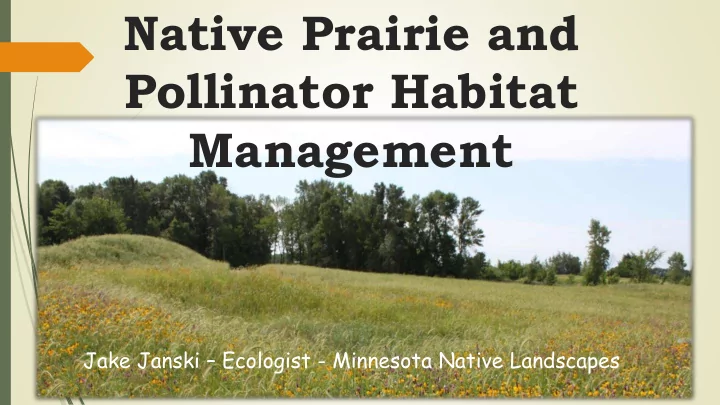

Native Prairie and Pollinator Habitat Management Jake Janski – Ecologist - Minnesota Native Landscapes
Re Restoring storing an and Ma Mana naging ging Na Nativ ive e Pla Plant nt Co Commu mmuni nities ties Creating and Maintaining a wide variety of Pollinator Habitats in the Upper Midwest Growing, installing and selling native seeds and plants Wildflowers, Prairie Grasses, Wetland Sedges
Re Restoring storing an and Ma Mana naging ging Na Nativ ive e Pla Plant nt Co Commu mmuni nities ties 15 years on the ground working with plants and people, on private and public lands Installation, Management, Planning, Consultation and Design 12 years managing seeded, planted or remnant plant communities Prairie, Wetland, Shoreline, Wetland, Savanna, Woodland Commercial applicator for 14 years
Native Prairie and Pollinator Habitat Management
Pollinator Benefits Human Food Supply Direct and indirect food production Food supply for wildlife Summer months- prey Winter months- seeds Native plant reproduction Ensuring a diverse seed bank Plant movement and colonization over the landscape Promotes healthy habitats for themselves and other wildlife
Pollinators share their habitats!
Pollinator Concerns Population declines Habitat Loss Reduced quality Pesticides Some known insecticide impacts Impacts from many other pesticides not clear Indirect impacts- non fatal but potential for other harms Chronic toxicity- not fully understood Disease Increased susceptibility because of other factors
Pollinators in Minnesota A wide array of native insect pollinator species are found in MN Bees- 350+ Butterflies- 100+ Moths- 2000+
Pollinators in Minnesota Bees In MN, only 5% of bee species are Honey Bees and Bumble Bees
Pollinators in Minnesota Butterflies
Pollinators in Minnesota Moths
Pollinators in Minnesota Other native insect pollinator species found in MN Wasps Ants Beetles Flies
Pollinators in Minnesota Honeybees Non native, “livestock”
Pollinator Habitat Pollinators in Native Plant Communities Native P lants and Native Pollinators have coevolved to each’s benefit Quality Habitats Provide: Forage Pollen- Protein and Fats Building materials, food for larvae Nectar- Carbohydrate and Sugars Immediate energy needs, refunded and stored Vegetation- Plant materials Larval food, nest building
Plant Material fritzhaeg.com
Pollinator Habitat Pollinators in Native Plant Communities Native plants and Native Pollinators have coevolved to each’s benefit Quality Habitats Provide: Shelter for all life stages Overwintering Larval Pupation Shelter Types: Cavities- Hollow plant stems for egg deposit and larval development Vegetation- Hanging a chrysalis/ cocoon Open soils- Ground nesting bees (70%) Burrows- Bumble bee colonies Dead wood- Tunnels made into soft pith
Shelter
Pollinator Habitat Prairies Diverse collection of primarily grasses, sedges and forbs with occasional shrubs Open grasslands, restored plantings, treeless corridors, cleared woodlands, roadsides, meadows, etc. Essential mid and late season food sources, shelter at all life phases
Pollinator Habitat Prairies and wetlands
Pollinator Habitat Prairies Diverse collection of primarily grasses, sedges and forbs with component of shrubs Open grasslands, restored plantings, treeless corridors, cleared woodlands, roadsides, meadows, etc. Essential mid and late season food sources, shelter at all life phases Savannas and Woodlands Trees, shrubs, forbs, grasses and sedges Early and late season food sources, many shelter opportunities
Pollinator Habitat Savannas and Woodlands
Pollinator Habitat Management Best Management Practices Avoid high quality habitat altogether Avoid treatments during times of daily peak pollinator activity Avoid treatments in certain areas at certain times of the year Provide refugia in or around intensive work areas Avoid insecticides, especially neonicotinoids
Pollinator Habitat Management Site Assessments Are Key Determine the quality of the habitat within you work area(s) Determine if high quality areas can be treated early in the day, or very late Determine if woodlands can be treated in summer, prairies in spring Determine if any areas can be completely avoided at this time Determine if insecticides or herbicides are needed to achieve the site goals Is Integrated Pest Management (IPM) part of your planning? Optimally, IPM addresses the root cause of the problem using all available practices Based on a site’s individual needs and characteristic
Habitat Management IPM Implementation Spraying- Treating certain perennial weeds and site prep Mowing- Control annual and biennial weeds Burning- Rejuvenating native species and controlling woodies Haying- Removing excessive material where burning may not be possible Grazing- Defoliating woody regrowth or other targeted weed types Weeding- Removing small populations of weeds in sensitive areas No Action- Allowing nature to do the work over time Biocontrol- Available for certain species
Habitat Management When pesticides are appropriate: Know what the label allows and/or requires Read carefully the “Directions for Use” AND “Environmental Hazards” sections. Look for any Pollinator or Bee restrictions Even if no restriction exist at this time, consider the unknowns
Habitat Management IPM: Broadcast spraying before weeds bloom, when pollinators aren’t active
Habitat Management IPM: Prescribed burning to invigorate desirable native species
Habitat Management IPM: Mowing annual/ biennial weeds before blooming
Habitat Management IPM: Hand weeding individuals with small populations
Habitat Management Pesticide Applications: When timing cannot be controlled, make other adjustments Application methods Spot treatments verses broadcast spraying Wicking verses spraying Reduce off-target drift Lower pressure to increase droplet size Leave a buffer zone
Habitat Management Additional BMPs for Pollinator Habitat Leave dead herbaceous material standing over winter Leave dead and decaying wood in place Large scale disturbances should be rotated throughout a site over time Re-seed treated sites
Habitat Management Everything you do in natural areas will affect the pollinators that depend on that plant community. It’s far easier, cheaper and more effective to protect species than it is to revive them. Consider all of your options. Then do what you can to do a little harm as you can!
Questions ? Jake Janski MNLcorp.com jake@mnlcorp.com (612) 490-5992
Additional Resources on Protecting Pollinators and Their Habitats MDA: https://www.mda.state.mn.us/protecting/bm ps/pollinators.aspx MN DNR: http://www.dnr.state.mn.us/pollinator_resour ces/index.html/ Pollinators of Native Plants: http://www.pollinatorsnativeplants.com/ The Xerces Society: http://www.xerces.org/ Driftwatch: https://driftwatch.org/
Recommend
More recommend